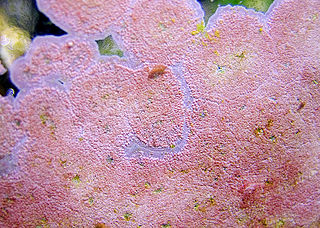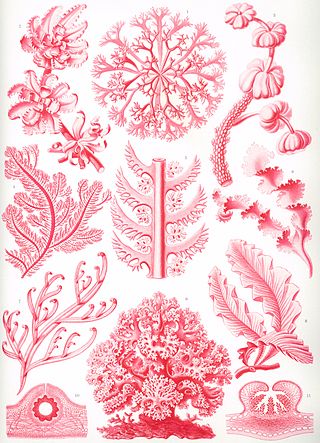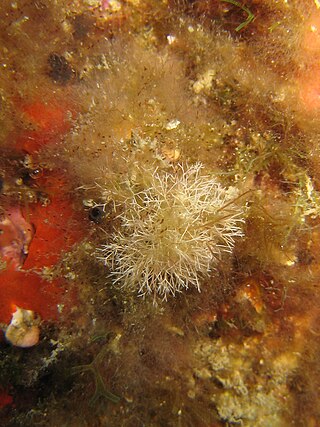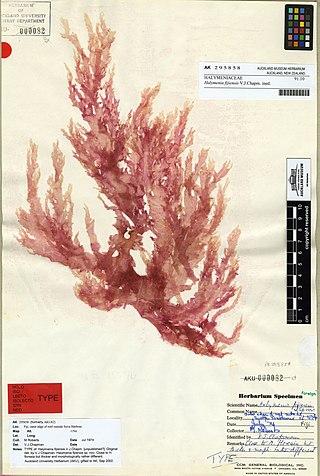
Coralline algae are red algae in the order Corallinales. They are characterized by a thallus that is hard because of calcareous deposits contained within the cell walls. The colors of these algae are most typically pink, or some other shade of red, but some species can be purple, yellow, blue, white, or gray-green. Coralline algae play an important role in the ecology of coral reefs. Sea urchins, parrot fish, and limpets and chitons feed on coralline algae. In the temperate Mediterranean Sea, coralline algae are the main builders of a typical algal reef, the Coralligène ("coralligenous"). Many are typically encrusting and rock-like, found in marine waters all over the world. Only one species lives in freshwater. Unattached specimens may form relatively smooth compact balls to warty or fruticose thalli.

Florideophyceae is a class of exclusively multicellular red algae. They were once thought to be the only algae to bear pit connections, but these have since been found in the filamentous stage of the Bangiaceae. They were also thought only to exhibit apical growth, but there are genera known to grow by intercalary growth. Most, but not all, genera have three phases to the life cycle. In the subclass Nemaliophycidae there are three orders, Balbianiales, Batrachospermales, and Thoreales, which lives exclusively in freshwater.

Crustose is a habit of some types of algae and lichens in which the organism grows tightly appressed to a substrate, forming a biological layer. Crustose adheres very closely to the substrates at all points. Crustose is found on rocks and tree bark. Some species of marine algae of the Rhodophyta, in particular members of the order Corallinales, family Corallinaceae, subfamily Melobesioideae with cell walls containing calcium carbonate grow to great depths in the intertidal zone, forming crusts on various substrates. The substrate can be rocks throughout the intertidal zone, or, as in the case of the Corallinales, reef-building corals, and other living organisms including plants, such as mangroves and animals such as shelled molluscs. The coralline red algae are major members of coral reef communities, cementing the corals together with their crusts. Among the brown algae, the order Ralfsiales comprises two families of crustose algae.

Conceptacles are specialized cavities of marine and freshwater algae that contain the reproductive organs. They are situated in the receptacle and open by a small ostiole. Conceptacles are present in Corallinaceae, and Hildenbrandiales, as well as the brown Fucales. In the Fucales there is no haploid phase in the reproductive cycle and therefore no alternation of generations. The thallus is a sporophyte. The diploid plants produce male (antheridia) and female (oogonia) gametangia by meiosis. The gametes are released into the surrounding water; after fusion, the zygote settles and begins growth.
Wataru Ishijima was a paleontologist and geologist. Ishijima was one of the most prolific researchers of fossil calcareous algae. After graduating from the Imperial Fisheries Institute in 1927, Ishijima joined the Institute of Geology and Paleontology, Faculty of Science, Tohoku Imperial University (Sendai) from 1927–1931. He then worked at the Institute of Geology, Taihoku Imperial University (Taipei) during 1942–1945 and then at the Rikkyo University (Tokyo) from 1945–1980. His doctoral dissertation was submitted to Tohoku University and was privately published by Yūhodō. He described a total of 139 taxa of fossil calcareous algae including at least 114 species of Corallinales, and he produced more than 45 publications on coralline algal taxonomy.

The Corallinaceae are one of the two extant Coralline families of red algae; they are differentiated from the morphologically similar Sporolithaceae by their formation of grouped sporangial chambers, clustered into sori. The Corallinoideae is monophyletic; the other subfamilies form another monophyletic group.
The Rhodogorgonales are an order of red algae, a sister group to the corallines. They are always thalloid and calcified; their calcification is very different from the corallines, as individual calcite crystals are deposited in the cell wall of specialised cells; this suggests that the evolution of calcification may have been independent from the corallines. They have no fossil record.

Red algae, or Rhodophyta, make up one of the oldest groups of eukaryotic algae. The Rhodophyta comprises one of the largest phyla of algae, containing over 7,000 recognized species within over 900 genera amidst ongoing taxonomic revisions. The majority of species (6,793) are Florideophyceae, and mostly consist of multicellular, marine algae, including many notable seaweeds. Red algae are abundant in marine habitats. Approximately 5% of red algae species occur in freshwater environments, with greater concentrations in warmer areas. Except for two coastal cave dwelling species in the asexual class Cyanidiophyceae, no terrestrial species exist, which may be due to an evolutionary bottleneck in which the last common ancestor lost about 25% of its core genes and much of its evolutionary plasticity.
The Mastophoroideae are a subfamily of Corallinaceaen coralline algae with uniporate conceptacles.

The Lithophylloideae are a monophyletic subfamily of Corallinaceaen Coralline algae with uniporate conceptacles.
The Metagoniolithoideae are a monogeneric subfamily of genucilate Corallinaceaen coralline algae.

The Corallinoideae are a subfamily of coralline algae. All its genera are geniculate.
The Choreonematoideae are a monogeneric nongeniculate subfamily of Coralline algae.

The Corallinophycidae is a grouping of several calcifying red algal lineages recovered by molecular analysis.
Marie Dujardin Beaumetz Lemoine (1887–1984) was a French botanist and phycologist noted for her study of the algae Corallinales and her work at the National Museum of Natural History (France). She married French geologist Paul Lemoine. The standard author abbreviation Me.Lemoine is used to indicate this person as the author when citing a botanical name.

Lithophyllum orbiculatum is a species of thalloid coralline algae, which are a red algae whose cell walls contain calcareous deposits.

Liagoraceae is a family of red algae (Rhodophyta) in the order Nemaliales. The type genus is LiagoraJ.V.Lamouroux.

Halymeniales is an order of red algae belonging to the class Florideophyceae and the subclass Rhodymeniophycidae.

Peyssonneliales is a monotypic order of red algae belonging to the class Florideophyceae and the subclass Rhodymeniophycidae. It contains only 1 known family, PeyssonneliaceaeDenizot, M., 1968.

Pneophyllum is a genus of multicellular red algae in the family Corallinaceae and subfamily Mastophoroideae.













